Liposomal Nanocarriers Designed for Sub-Endothelial Matrix Targeting under Vascular Flow Conditions
Abstract
:1. Introduction
2. Materials and Methods
2.1. Liposome Constituents
2.2. CTP-Modified Lipid Synthesis
2.3. Non-Targeting Liposome (PLP) Assembly
2.4. CT-PLP Assembly
2.4.1. Modification via Pre-Insertion (PreCTL)
2.4.2. Modification via Post-Insertion (PostCTL)
2.5. Liposome Characterization Studies
2.5.1. Size and Homogeneity
2.5.2. Morphologic Characterization by Scanning Transmission Electron Microscopy (STEM)
2.6. Static Collagen-Binding Assays
2.7. Collagen Binding under Hemodynamic Flow
2.8. Human Vessel Explant Binding under Ex Vivo Perfusion
2.9. Statistical Analysis
3. Results
3.1. EtOH Injection Assembly of CT-PLPs Results in Homogenous ~50 nm Liposome Samples
3.2. CT-PLPs Demonstrate Significant Binding Affinity for Collagen IV Matrices under Static Conditions Compared to Non-Targeted PLP Controls
3.3. CT-PLPs Formed by the Pre-Insertion of CTL Demonstrate Early and Increased Binding over CT-PLPs Formed by Post-Insertion and PLP Controls
3.4. CT-PLPs Demonstrate Binding Affinity to Collagen IV Matrices under Flow Conditions Mimicking Vessel Wall Hemodynamics
3.5. CT-PLPs Demonstrate Binding Affinity to Human Lower Extremity Vessel Explants under Ex Vivo Vascular Perfusion
4. Discussion
5. Conclusions
Author Contributions
Funding
Institutional Review Board Statement
Informed Consent Statement
Data Availability Statement
Conflicts of Interest
References
- Dangas, G.; Kuepper, F. Cardiology patient page. Restenosis: Repeat narrowing of a coronary artery: Prevention and treatment. Circulation 2002, 105, 2586–2587. [Google Scholar] [CrossRef] [Green Version]
- Schiele, T.M.; Krotz, F.; Klauss, V. Vascular restenosis-striving for therapy. Expert Opin. Pharm. 2004, 5, 2221–2232. [Google Scholar] [CrossRef]
- Seedial, S.M.; Ghosh, S.; Saunders, R.S.; Suwanabol, P.A.; Shi, X.; Liu, B.; Kent, K.C. Local drug delivery to prevent restenosis. J. Vasc. Surg. 2013, 57, 1403–1414. [Google Scholar] [CrossRef] [PubMed] [Green Version]
- Grube, E.; Silber, S.; Hauptmann, K.E.; Mueller, R.; Buellesfeld, L.; Gerckens, U.; Russell, M.E. TAXUS I: Six- and twelve-month results from a randomized, double-blind trial on a slow-release paclitaxel-eluting stent for de novo coronary lesions. Circulation 2003, 107, 38–42. [Google Scholar] [CrossRef] [Green Version]
- Kastrati, A.; Mehilli, J.; von Beckerath, N.; Dibra, A.; Hausleiter, J.; Pache, J.; Schuhlen, H.; Schmitt, C.; Dirschinger, J.; Schomig, A.; et al. Sirolimus-eluting stent or paclitaxel-eluting stent vs balloon angioplasty for prevention of recurrences in patients with coronary in-stent restenosis: A randomized controlled trial. JAMA 2005, 293, 165–171. [Google Scholar] [CrossRef] [Green Version]
- Tepe, G.; Zeller, T.; Albrecht, T.; Heller, S.; Schwarzwalder, U.; Beregi, J.P.; Claussen, C.D.; Oldenburg, A.; Scheller, B.; Speck, U. Local delivery of paclitaxel to inhibit restenosis during angioplasty of the leg. N. Engl. J. Med. 2008, 358, 689–699. [Google Scholar] [CrossRef] [Green Version]
- Torguson, R.; Sabate, M.; Deible, R.; Smith, K.; Chu, W.W.; Kent, K.M.; Pichard, A.D.; Suddath, W.O.; Satler, L.F.; Waksman, R. Intravascular brachytherapy versus drug-eluting stents for the treatment of patients with drug-eluting stent restenosis. Am. J. Cardiol. 2006, 98, 1340–1344. [Google Scholar] [CrossRef] [PubMed]
- Gabizon, A.; Shmeeda, H.; Barenholz, Y. Pharmacokinetics of pegylated liposomal Doxorubicin: Review of animal and human studies. Clin. Pharm. 2003, 42, 419–436. [Google Scholar] [CrossRef]
- Li, S.D.; Huang, L. Stealth nanoparticles: High density but sheddable PEG is a key for tumor targeting. J. Control. Release 2010, 145, 178–181. [Google Scholar] [CrossRef] [PubMed] [Green Version]
- Pattni, B.S.; Chupin, V.V.; Torchilin, V.P. New Developments in Liposomal Drug Delivery. Chem. Rev. 2015, 115, 10938–10966. [Google Scholar] [CrossRef]
- Zylberberg, C.; Gaskill, K.; Pasley, S.; Matosevic, S. Engineering liposomal nanoparticles for targeted gene therapy. Gene Ther. 2017, 24, 441–452. [Google Scholar] [CrossRef] [PubMed]
- Anseth, K.S.; Klok, H.A. Click Chemistry in Biomaterials, Nanomedicine, and Drug Delivery. Biomacromolecules 2016, 17, 1–3. [Google Scholar] [CrossRef] [Green Version]
- Torchilin, V.P. Multifunctional nanocarriers. Adv. Drug Deliv. Rev. 2006, 58, 1532–1555. [Google Scholar] [CrossRef] [PubMed]
- Aryasomayajula, B.; Salzano, G.; Torchilin, V.P. Multifunctional Liposomes. Methods Mol. Biol. 2017, 1530, 41–61. [Google Scholar] [PubMed]
- Koren, E.; Torchilin, V.P. Cell-penetrating peptides: Breaking through to the other side. Trends Mol. Med. 2012, 18, 385–393. [Google Scholar] [CrossRef]
- Fisher, R.K.; Mattern-Schain, S.I.; Best, M.D.; Kirkpatrick, S.S.; Freeman, M.B.; Grandas, O.H.; Mountain, D.J. Mountain, Improving the efficacy of liposome-mediated vascular gene therapy via lipid surface modifications. J. Surg. Res. 2017, 219, 136–144. [Google Scholar] [CrossRef] [PubMed]
- Fisher, R.K.; West, P.C.; Mattern-Schain, S.I.; Best, M.D.; Kirkpatrick, S.S.; Dieter, R.A.; Arnold, J.D.; Buckley, M.R.; McNally, M.M.; Freeman, M.B.; et al. Advances in the Formulation and Assembly of Non-Cationic Lipid Nanoparticles for the Medical Application of Gene Therapeutics. Nanomaterials 2021, 11, 825. [Google Scholar] [CrossRef]
- Mattern-Schain, S.I.; Fisher, R.K.; West, P.C.; Grimsley, L.B.; Harris, T.M.; Grandas, O.H.; Best, M.D.; Mountain, D.J. Mountain, Cell mimetic liposomal nanocarriers for tailored delivery of vascular therapeutics. Chem. Phys. Lipids 2018, 218, 149–157. [Google Scholar] [CrossRef] [PubMed]
- Chan, J.M.; Zhang, L.; Tong, R.; Ghosh, D.; Gao, W.; Liao, G.; Yuet, K.P.; Gray, D.; Rhee, J.-W.; Cheng, J.; et al. Farokhzad, Spatiotemporal controlled delivery of nanoparticles to injured vasculature. Proc. Natl. Acad. Sci. USA 2010, 107, 2213–2218. [Google Scholar] [CrossRef] [Green Version]
- Best, M.D. Click chemistry and bioorthogonal reactions: Unprecedented selectivity in the labeling of biological molecules. Biochemistry 2009, 48, 6571–6584. [Google Scholar] [CrossRef]
- Chenoweth, K.; Chenoweth, D.; Goddard, W.A., III. Cyclooctyne-based reagents for uncatalyzed click chemistry: A computational survey. Org. Biomol. Chem. 2009, 7, 5255–5258. [Google Scholar] [CrossRef] [Green Version]
- Papaioannou, T.G.; Stefanadis, C. Vascular wall shear stress: Basic principles and methods. Hell. J. Cardiol. 2005, 46, 9–15. [Google Scholar]
- Givens, C.; Tzima, E. Endothelial Mechanosignaling: Does One Sensor Fit All? Antioxid. Redox Signal. 2016, 25, 373–388. [Google Scholar] [CrossRef] [Green Version]
- Fioole, B.; van de Rest, H.J.; Meijer, J.R.; van Leersum, M.; van Koeverden, S.; Moll, F.L.; van den Berg, J.C.; de Vries, J.P. Percutaneous transluminal angioplasty and stenting as first-choice treatment in patients with chronic mesenteric ischemia. J. Vasc. Surg. 2010, 51, 386–391. [Google Scholar] [CrossRef] [PubMed] [Green Version]
- Klein, W.M.; van der Graaf, Y.; Seegers, J.; Moll, F.L.; Mali, W.P. Long-term cardiovascular morbidity, mortality, and reintervention after endovascular treatment in patients with iliac artery disease: The Dutch Iliac Stent Trial Study. Radiology 2004, 232, 491–498. [Google Scholar] [CrossRef]
- Grandas, O.H.; Mountain, D.H.; Kirkpatrick, S.S.; Cassada, D.C.; Stevens, S.L.; Freeman, M.B.; Goldman, M.H. Regulation of vascular smooth muscle cell expression and function of matrix metalloproteinases is mediated by estrogen and progesterone exposure. J. Vasc. Surg. 2009, 49, 185–191. [Google Scholar] [CrossRef] [Green Version]
- Grandas, O.H.; Mountain, D.J.; Kirkpatrick, S.S.; Rudrapatna, V.S.; Cassada, D.C.; Stevens, S.L.; Freeman, M.B.; Goldman, M.H. Effect of hormones on matrix metalloproteinases gene regulation in human aortic smooth muscle cells. J. Surg. Res. 2008, 148, 94–99. [Google Scholar] [CrossRef] [PubMed]
- Mountain, D.J.; Freeman, B.M.; Kirkpatrick, S.S.; Beddies, J.W.; Arnold, J.D.; Freeman, M.B.; Goldman, M.H.; Stevens, S.L.; Klein, F.A.; Grandas, O.H. Androgens regulate MMPs and the cellular processes of intimal hyperplasia. J. Surg. Res. 2013, 184, 619–627. [Google Scholar] [CrossRef] [PubMed]
- Mountain, D.J.; Freeman, M.B.; Kirkpatrick, S.S.; Cook, R.B.; Chalk, J.E.; Stevens, S.L.; Goldman, M.H.; Grandas, O.H. Effect of hormone replacement therapy in matrix metalloproteinase expression and intimal hyperplasia development after vascular injury. Ann. Vasc. Surg. 2013, 27, 337–345. [Google Scholar] [CrossRef] [PubMed]
- Mountain, D.J.; Kirkpatrick, S.S.; Freeman, M.B.; Stevens, S.L.; Goldman, M.H.; Grandas, O.H. Role of MT1-MMP in estrogen-mediated cellular processes of intimal hyperplasia. J. Surg. Res. 2012, 173, 224–231. [Google Scholar] [CrossRef]
- Tummers, A.M.; Mountain, D.J.; Mix, J.W.; Kirkpatrick, S.S.; Cassada, D.C.; Stevens, S.L.; Freeman, M.B.; Goldman, M.H.; Grandas, O.H. Serum levels of matrix metalloproteinase-2 as a marker of intimal hyperplasia. J. Surg. Res. 2010, 160, 9–13. [Google Scholar] [CrossRef]
- Iden, D.L.; Allen, T.M. In vitro and in vivo comparison of immunoliposomes made by conventional coupling techniques with those made by a new post-insertion approach. Biochim. Biophys. Acta 2001, 1513, 207–216. [Google Scholar] [CrossRef] [Green Version]
- Lee, S.H.; Sato, Y.; Hyodo, M.; Harashima, H. Topology of Surface Ligands on Liposomes: Characterization Based on the Terms, Incorporation Ratio, Surface Anchor Density, and Reaction Yield. Biol. Pharm. Bull. 2016, 39, 1983–1994. [Google Scholar] [CrossRef] [PubMed] [Green Version]
- Moreira, J.N.; Ishida, T.; Gaspar, R.; Allen, T.M. Use of the post-insertion technique to insert peptide ligands into pre-formed stealth liposomes with retention of binding activity and cytotoxicity. Pharm. Res. 2002, 19, 265–269. [Google Scholar] [CrossRef] [PubMed] [Green Version]
- Torchilin, V.P. Multifunctional, stimuli-sensitive nanoparticulate systems for drug delivery. Nat. Rev. Drug Discov. 2014, 13, 813–827. [Google Scholar] [CrossRef] [Green Version]

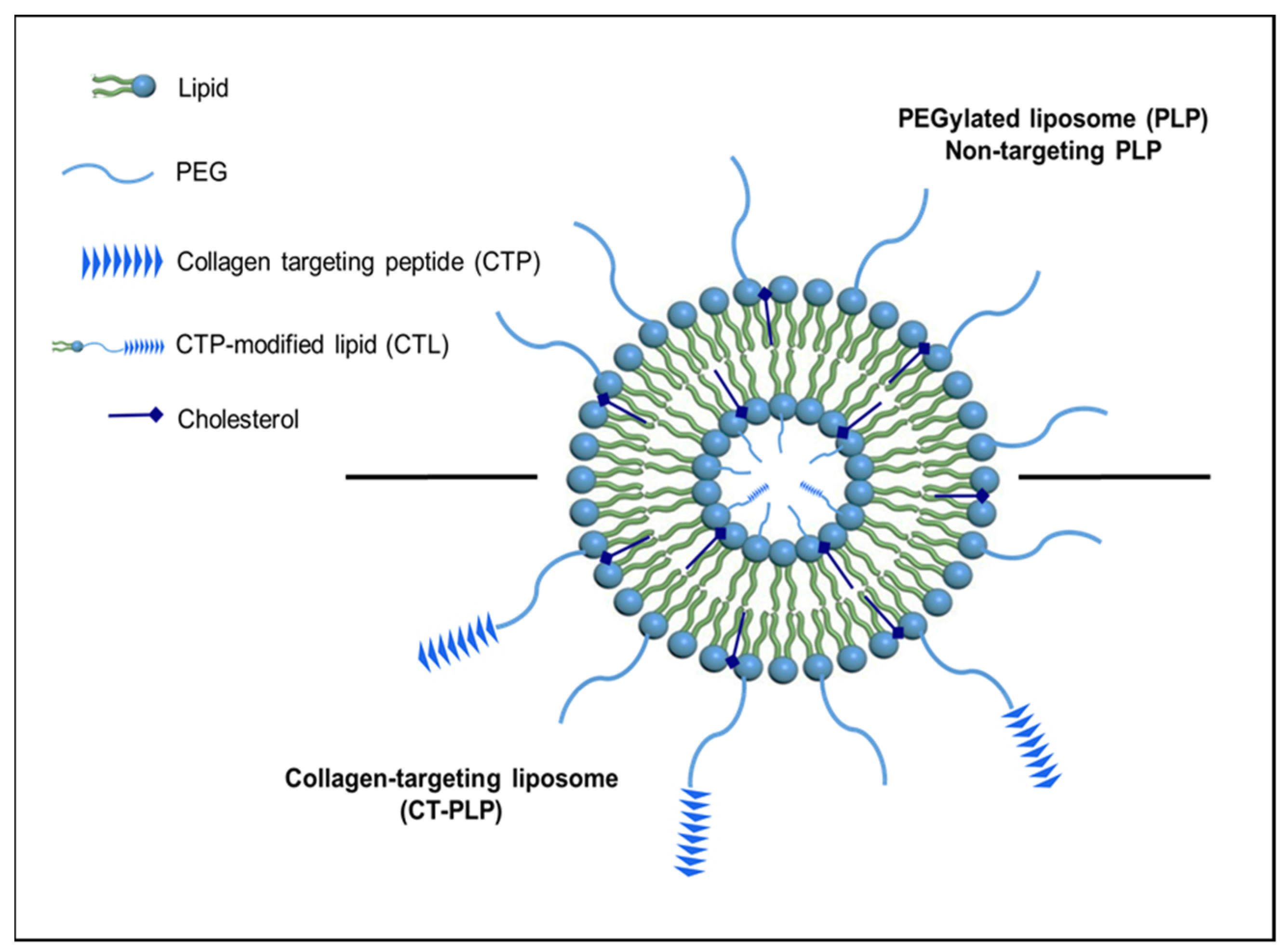

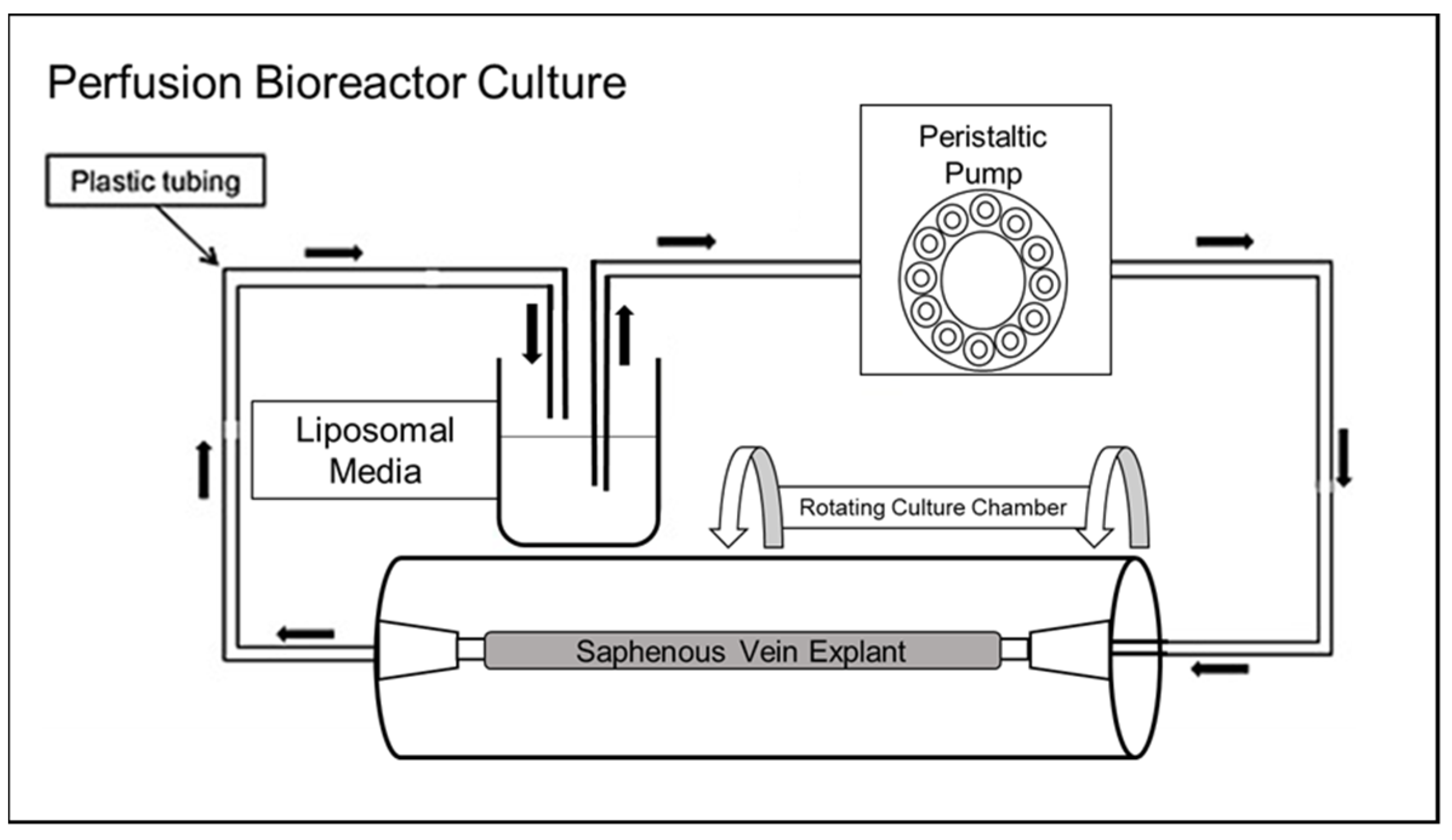

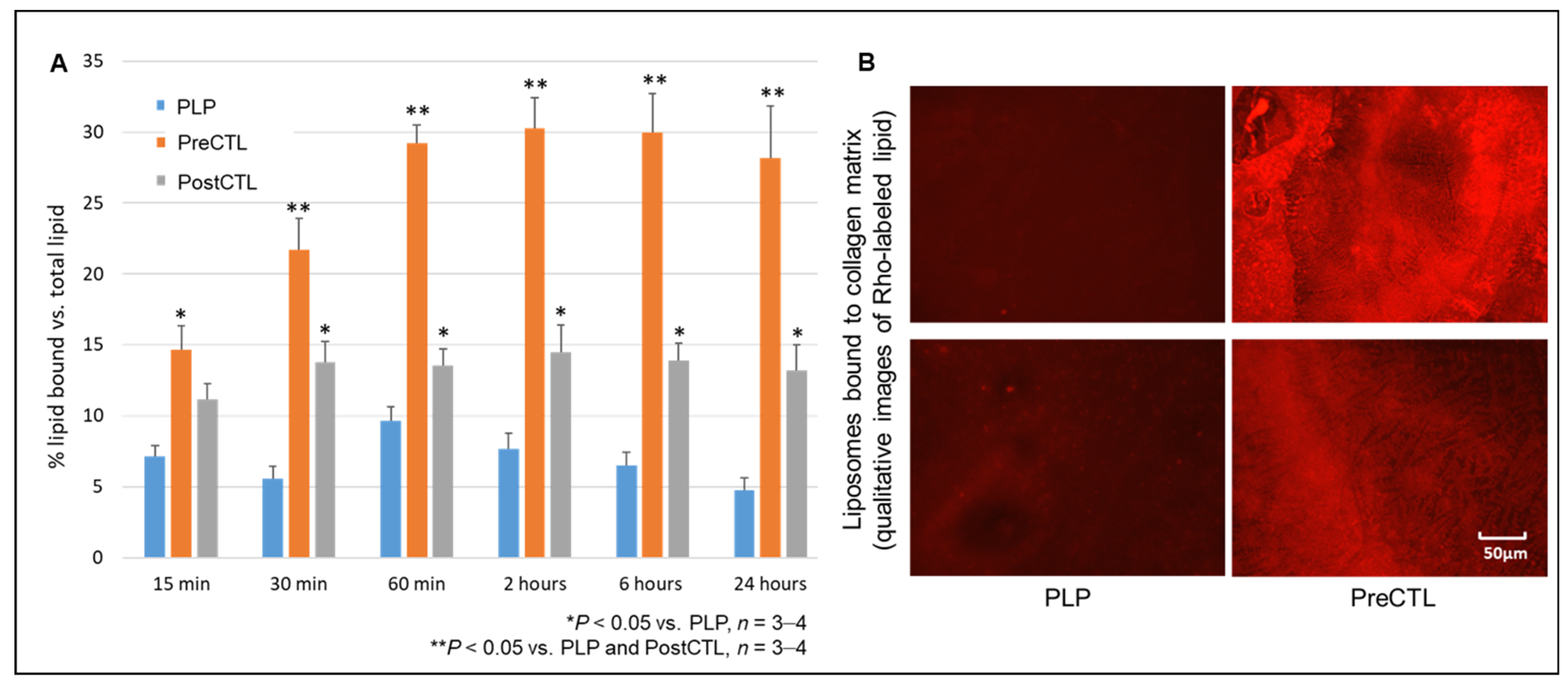
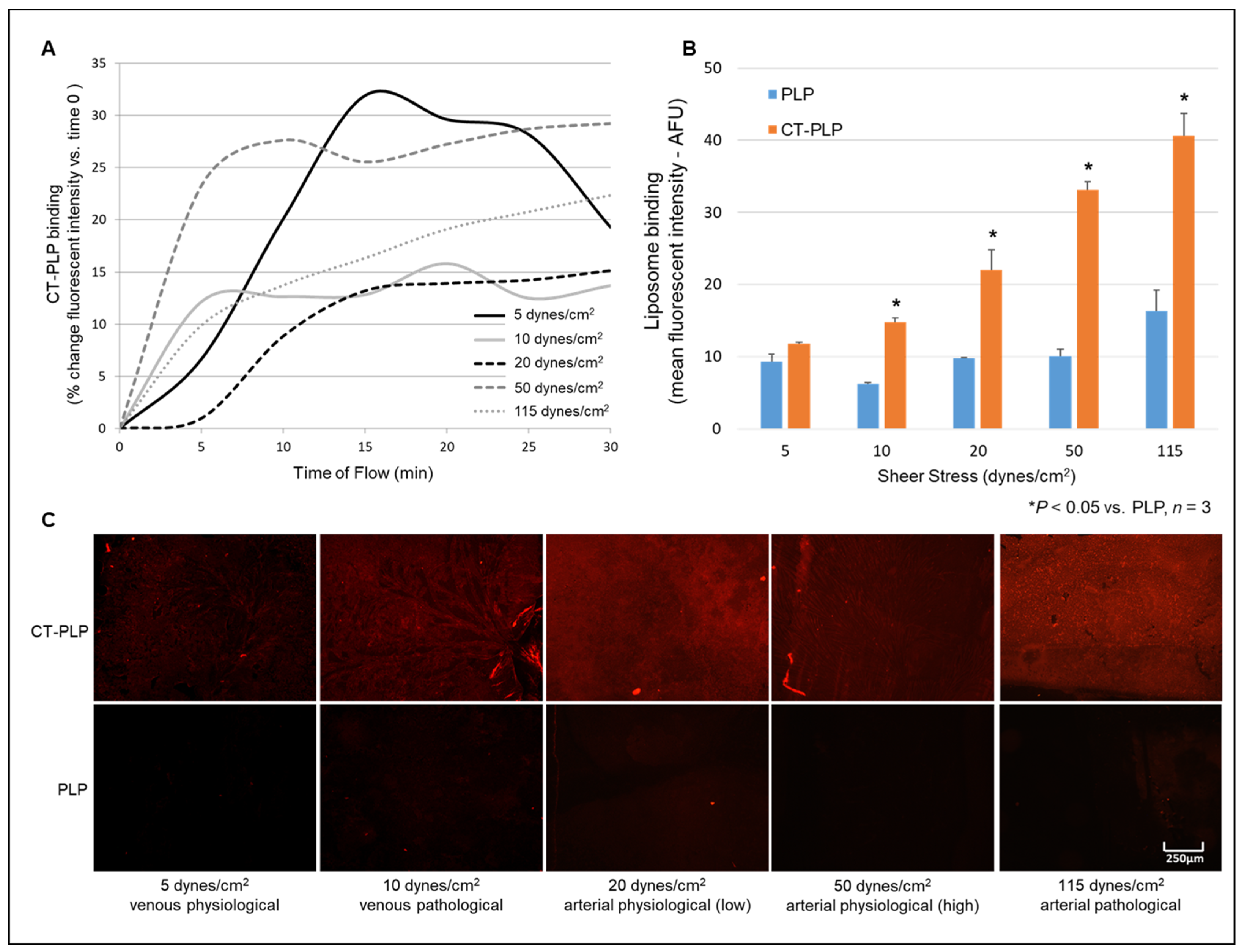
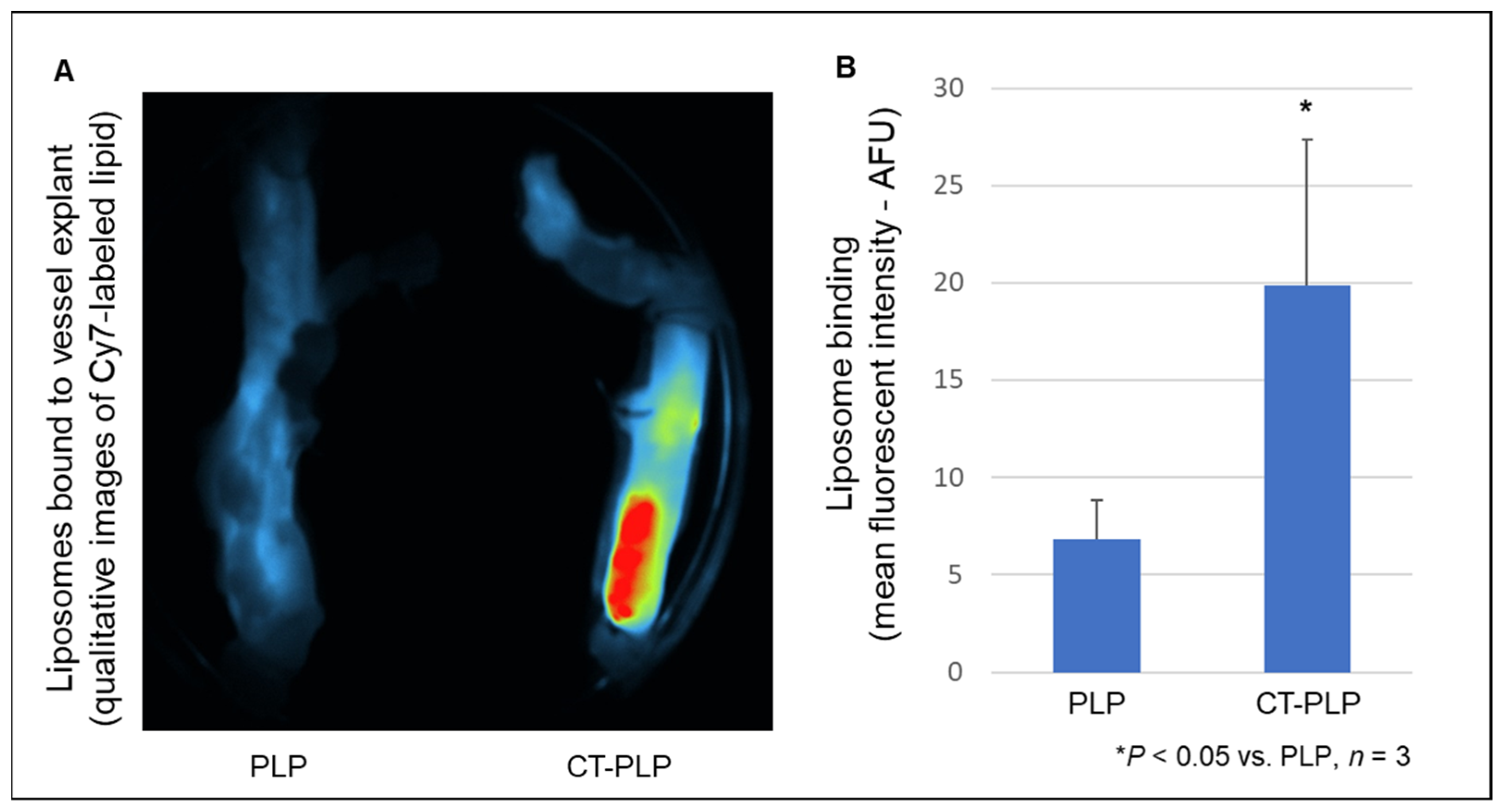
| Lipid Derivative/Constituent | Acronym |
|---|---|
| 1,2-distearoyl-sn-glycero-3-phosphoethanolamine-N-[methoxy(polyethylene glycol)-2000] | DSPE-PEG |
| 1,2-distearoyl-sn-glycero-3-phosphoethanolamine-N-[dibenzocyclooctyl(polyethylene glycol)-2000] | DSPE-PEG-DBCO |
| 1,2-dioleoyl-sn-glycero-3-phosphocholine | DOPC |
| N-(lissamine rhodamine B sulfonyl)-1,2-dipalmitoyl-sn-glycero-3-phosphoethanolamine | Rho-DPPE |
| N-(Cyanine 7)-1,2-dioleoyl-sn-glycero-3-phosphoethanolamine | Cy7-DOPE |
| Ovine cholesterol KLWVLPKK(N3)-NH2 | Chol CTP |
| Mol % CTL | Size (nm) | PDI | z-Potential | |
| PLP | 0 | 60 ± 9 | 0.21 ± 0.07 | 6.20 ± 0.75 |
| CT-PLP | 0.5 | 46 ± 2 | 0.32 ± 0.20 | 6.03 ± 1.28 |
| 1 | 49 ± 2 | 0.12 ± 0.01 | 7.62 ± 0.22 | |
| 2.5 | 50 ± 2 | 0.13 ± 0.01 | 7.35 ± 0.43 | |
| 5 | 51 ± 3 | 0.17 ± 0.01 | 8.03 ± 0.27 | |
| 10 | 508 ± 210 | 0.44 ± 0.05 | 8.02 ± 0.17 | |
| 15 | 588 ± 158 | 0.38 ± 0.10 | 9.01 ± 0.29 |
Publisher’s Note: MDPI stays neutral with regard to jurisdictional claims in published maps and institutional affiliations. |
© 2021 by the authors. Licensee MDPI, Basel, Switzerland. This article is an open access article distributed under the terms and conditions of the Creative Commons Attribution (CC BY) license (https://creativecommons.org/licenses/by/4.0/).
Share and Cite
Grimsley, L.B.; West, P.C.; McAdams, C.D.; Bush, C.A.; Kirkpatrick, S.S.; Arnold, J.D.; Buckley, M.R.; Dieter, R.A., III; Freeman, M.B.; McNally, M.M.; et al. Liposomal Nanocarriers Designed for Sub-Endothelial Matrix Targeting under Vascular Flow Conditions. Pharmaceutics 2021, 13, 1816. https://doi.org/10.3390/pharmaceutics13111816
Grimsley LB, West PC, McAdams CD, Bush CA, Kirkpatrick SS, Arnold JD, Buckley MR, Dieter RA III, Freeman MB, McNally MM, et al. Liposomal Nanocarriers Designed for Sub-Endothelial Matrix Targeting under Vascular Flow Conditions. Pharmaceutics. 2021; 13(11):1816. https://doi.org/10.3390/pharmaceutics13111816
Chicago/Turabian StyleGrimsley, Lauren B., Phillip C. West, Callie D. McAdams, Charles A. Bush, Stacy S. Kirkpatrick, Joshua D. Arnold, Michael R. Buckley, Raymond A. Dieter, III, Michael B. Freeman, Michael M. McNally, and et al. 2021. "Liposomal Nanocarriers Designed for Sub-Endothelial Matrix Targeting under Vascular Flow Conditions" Pharmaceutics 13, no. 11: 1816. https://doi.org/10.3390/pharmaceutics13111816






